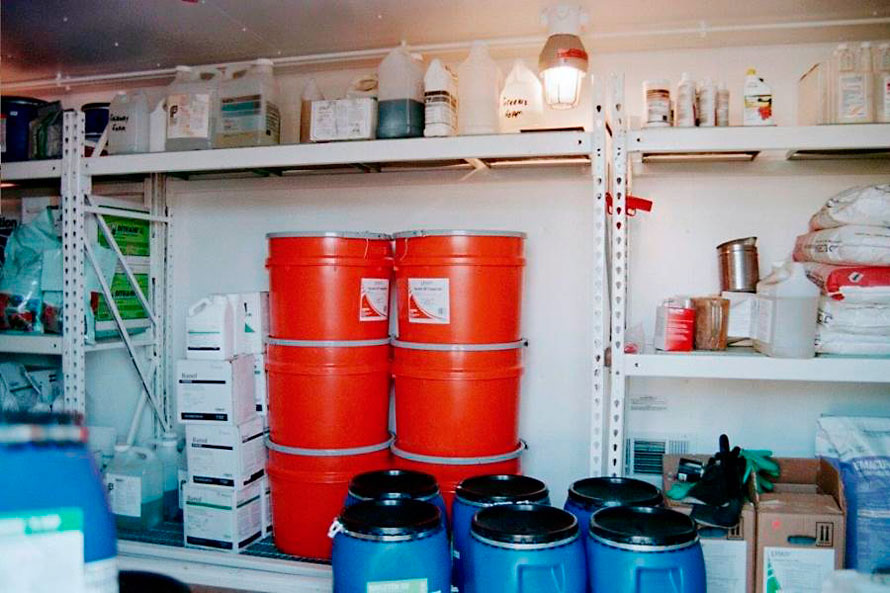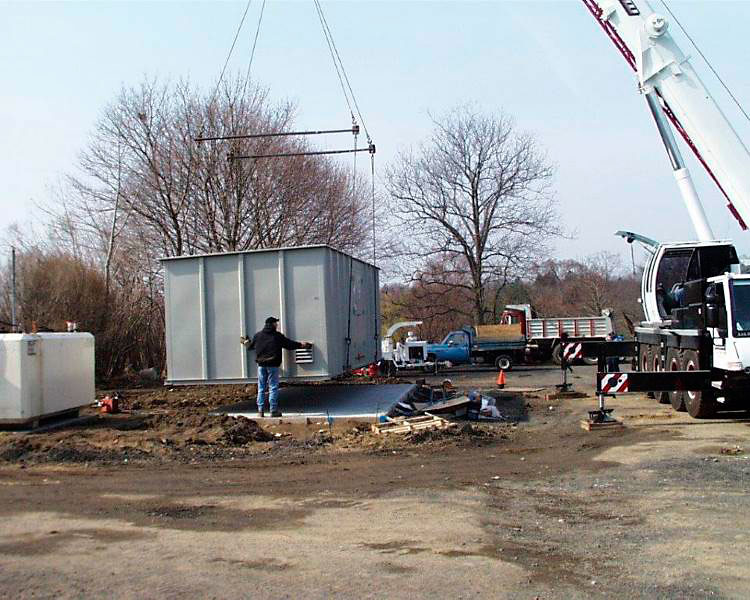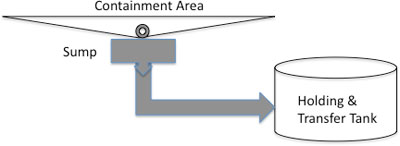The goal of an ideal storage facility is the safe siting and storage of potential contaminants that ensures a high level of water quality protection. NYSDOH does not allow chemical storage or mixing and loading facilities within 100 feet of a potable well. Other requirements include local zoning for the siting of maintenance facility and operations, which vary by town and county. Requirements often include a minimum distance (set-back) from wetlands, surface wells and property lines. The state’s Freshwater Wetlands Act requires a 100 ft buffer around wetlands. Some townships have even broader requirements.
 Chemical storage building organization. Source: Robert Alonzi.
Chemical storage building organization. Source: Robert Alonzi.Modular or independent containment units can be installed in many sizes. The units are typically self-contained, fireproof and secure and can be temperature controlled with ventilation. Options include fire suppression, eye washes, and safety showers.

Modular containment units can be installed in many sizes. Source: Robert Alonzi.
Floor drains should include a sump and a chemical pump to move the chemicals discharged to a waste tank as in the figure below. The material can be reclaimed, diluted to label concentrations, and applied to turf areas or collected for disposal using certified hazmat haulers.

Containment area with sump and transfer to holding tank.
Chemical Storage Guidelines
Below are guidelines for chemical storage. With respect to the storage of pesticides specifically, the pesticide label is the law and all pesticides should be stored according to instructions on their labels. In addition to the label, Part 326.11 of the New York Codes, Rules and Regulations states “No person shall store any restricted pesticide or empty containers thereof in such a manner as may be injurious to human, plant or animal life or to property or which unreasonably interferes with the comfortable enjoyment of life and property throughout such areas of the State as shall be affected thereby.” Pesticide storage areas should be designed and managed in a manner that prevents or minimizes the risk of injury, harm to the environment or any impact on the use or value of property.
The following suggestions are offered for consideration:
- Storage facilities should be structurally separate from “residential, office and general work areas; livestock quarters, food, feed or seed storage and water supply sources”. Storage should be in separate buildings and situated to be at least 50 ft away from residential or farm property. Fencing is currently not stipulated but could be considered as an added precaution.
- Storage areas should have a raised berm on all sides and an impervious surface for containment.
- Facilities should be equipped with “spill containment material” and fire extinguishers. Suggested spill containment material includes absorbent spill containment pads, sweeping compound, brushes or brooms, a dust pan, shovel and a disposal container or bag.
- Protective equipment should be available near but not within the storage area.
- The storage facility should be locked and properly posted with warnings.
- Annual updates should be provided to the local fire department and include a “Fire and Spill Response Plan”. Additional precautions might include provisions of the National Fire Protection Association (NFPA) codes.
- Chemicals should be segregated by function (e.g. fungicide, insecticide, and herbicide) and hazard level. All flammable and “incompatible” materials should be stored separately.
- Mixing areas should be similarly bermed with impervious surfaces.
- Indoor mixing areas should be properly vented.
- Bulk containers, construed to be equal to or greater than 55 gallons, should be locked and drains should be used to collect any spills into a containment area. The spill containment system should have a capacity equal to or greater than 25% of the volume of pesticides stored.
- A water supply and wash station are required at or adjacent to the facility for emergencies.
- A suitable first aid kit for pesticide poisoning should be nearby.
- Forced air vent systems capable of exchanging the air volume 3 to 4 times per hour should be considered along with temperature control for keeping temperatures under 95°F and above freezing.
- Local fire departments should be made aware of the pesticides and fertilizers stored to prepare in event of a fire at the storage facility.
Very old or inadequate storage areas may or may not be out of compliance, but consider planning for improvements to implement these guidelines over time. Updating chemical storage areas does not necessarily require a new building. Many changes can be easily attained to meet guidelines, such as:
- impervious flooring
- flooring sloped to a drain
- curbing to contain at least 25% of the volume of liquid chemicals and fertilizers stored
- ventilation to exhaust any fumes in the event of a spill
- PPE for workers and emergency wash stations
